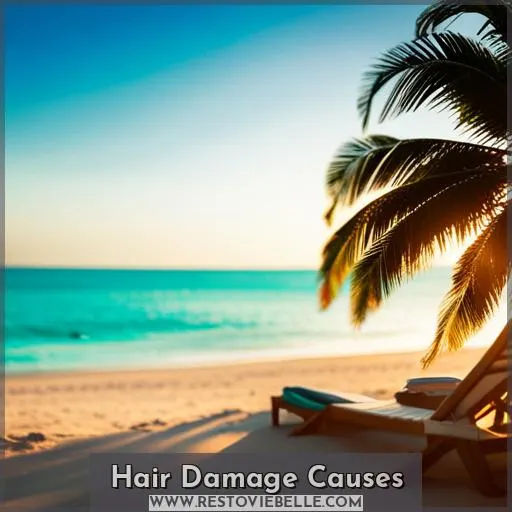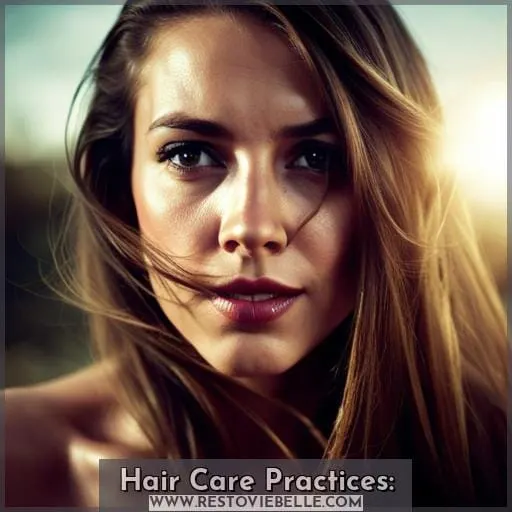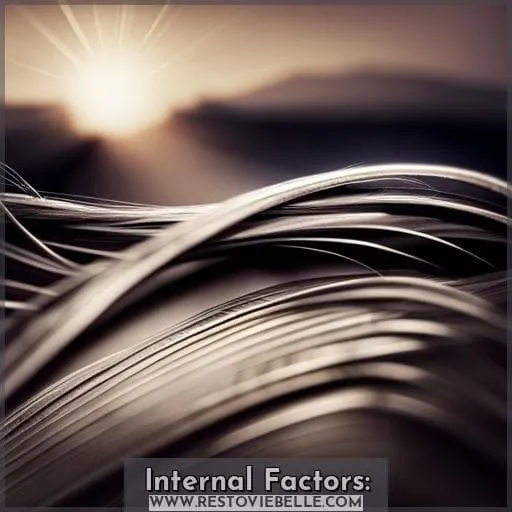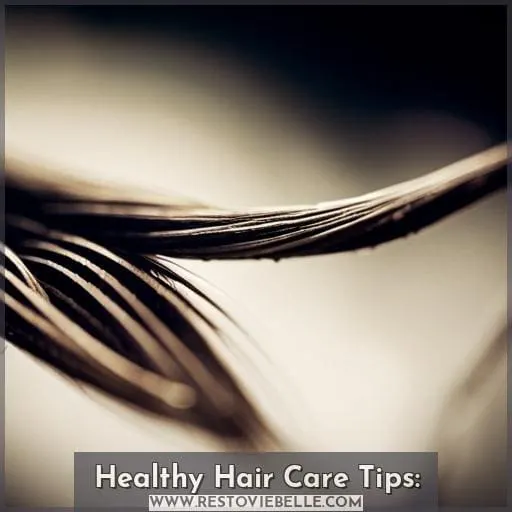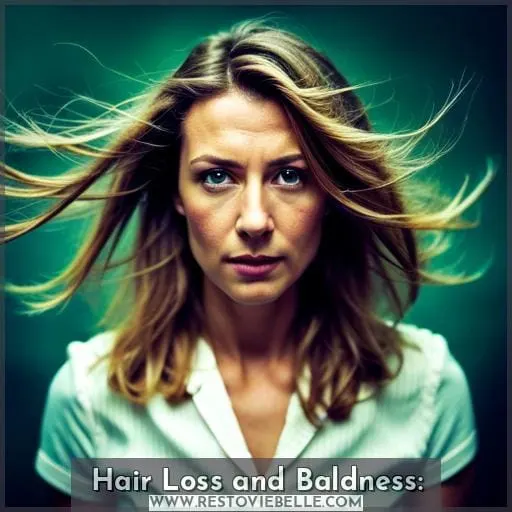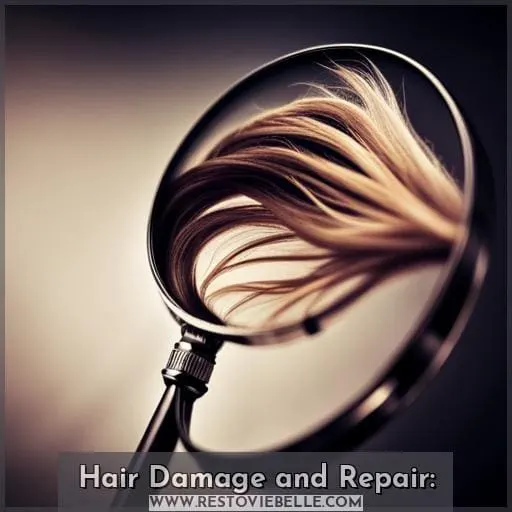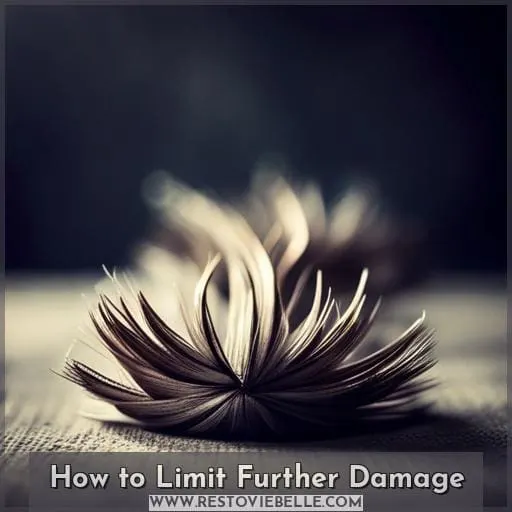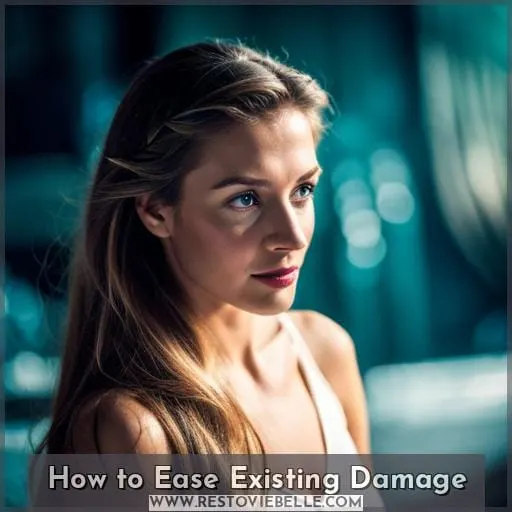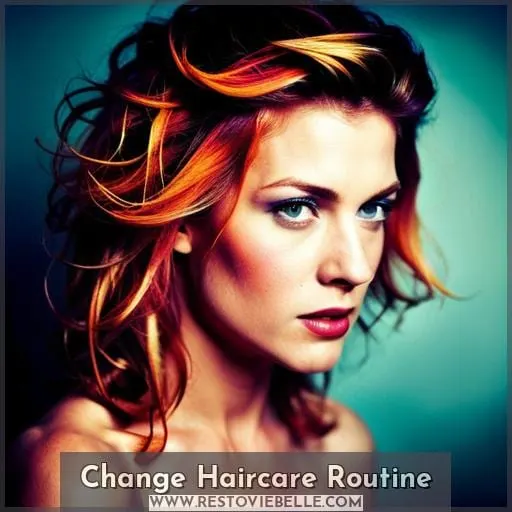This site is supported by our readers. We may earn a commission, at no cost to you, if you purchase through links.
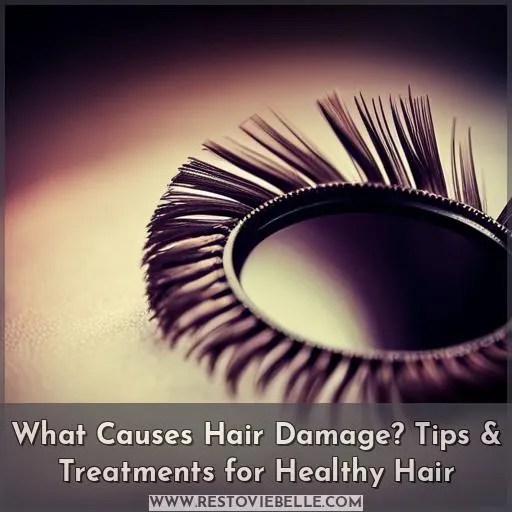 Do you know what causes hair damage? Do you want to learn how to keep your locks looking healthy and beautiful all year round? Well, the answer lies in understanding the different factors that can cause damage, including external factors such as heat styling tools or chemical treatments.
Do you know what causes hair damage? Do you want to learn how to keep your locks looking healthy and beautiful all year round? Well, the answer lies in understanding the different factors that can cause damage, including external factors such as heat styling tools or chemical treatments.
It’s also important to understand internal conditions like stress or hypothyroidism.
Table Of Contents
Key Takeaways
- External factors such as heat styling tools, chemical treatments, and tight hair ties contribute to hair damage.
- Internal conditions like stress and hypothyroidism can also lead to hair damage.
- To prevent and protect against hair damage, it is important to use heat-protecting sprays, limit heat tool usage, opt for air drying, exercise caution with dyes and bleach, choose fabric hair ties over rubber bands, and practice gentle towel drying.
- Other healthy hair care practices include optimal washing frequency, using wide-tooth combs for brushing, regular trims every 6-8 weeks to prevent split ends, maintaining a nutrient-rich diet, managing stress, and seeking medical advice for conditions like hypothyroidism and eating disorders.
Hair Damage Causes
You can damage your hair from external factors like heat styling tools, chemical treatments, and tight hair ties, as well as internal factors such as stress. For example, if you frequently use a flat iron to style your hair at high temperatures without applying any protective products beforehand, you’re likely to experience some degree of damage.
To prevent heat-related breakage, it’s important to limit the use of heating tools. Use those that have adjustable temperature settings and protecting spray. Chemical dyes should also be avoided or used in moderation.
Hair ties should always be made from fabric materials instead of rubber bands, which can tug on the scalp causing breakage over time. When towel drying after washing, try not to rub the wet strands. Instead, blot them gently or leave a small towel draped around until dry to avoid split ends forming due to excessive friction against other surfaces like clothing fibers.
Paying attention to these details is key for maintaining healthy-looking locks free from unnecessary damage.
External Factors:
You may be damaging your hair without even knowing it. Heat styling tools, chemical treatments, overuse of styling tools, and tight hair ties can all cause damage to the cuticle layer in your hair. If you’re not careful with how you dry your wet strands, either by rubbing or using an incorrect towel, this too can also lead to breakage.
Heat and Styling Tools
High heat can fry your strands, so keep temperatures low and spritz on a protective spray before styling. Chemical treatments like relaxers and elastic ties should be avoided to prevent breakage. Towel blotting is better than rubbing wet hair for drying, while gentle scalp shampooing will help protect from damage due to overuse of products or tools.
Chemical Treatments
Chemical treatments like perms, coloring, and relaxers can cause considerable damage to your hair. Chemical dyes may weaken the structure and lead to dryness or breakage. Relaxers can cause scalp irritation if they are not used correctly.
Color treatments contain high amounts of heat that could harm fragile strands when combined with other styling tools, such as curling irons or flat irons. Bleach damages by stripping away pigment from the hair shaft, making it prone to breakage and split ends.
Consider using natural alternatives instead of bleach for color changes at home! Hair dyeing brings risks when done incorrectly – always go to a professional stylist for the best results with minimal damage! Avoid overuse of chemical products as much as possible.
Overuse of Styling Tools
Excessive use of styling tools can cause breakage, so try to keep it to a minimum. Heat damage from hot rollers, curling irons, and other tools should be avoided with protective sprays and lower temperatures.
Hair ties should not be too tight or made of rubber bands in order to prevent damage. When towel drying hair, avoid rubbing wet locks; instead, blot gently or leave the towel in until dry for optimal results, avoiding further hair damage.
Tight Hair Ties
| Tight hair ties can pull your locks too hard, causing them to stretch past their breaking point — like a rubber band snapping. Heat protection and proper ties will help keep elasticity intact while dietary needs and avoiding stress prevent hair thinning and loss. Hair cuticle damage increases with tight hairstyles, so use elastic bands carefully for maximum health! | Avoiding Stress | Dietary Needs | Elastic Bands |
|---|---|---|---|
| ️ | ️ | ️ |
Incorrect Towel Drying
Avoid rubbing wet hair. Gently blot it with a towel to prevent damage. Use heat methods instead for better absorption, using only proper tools like hair ties and combs.
Hair Care Practices:
Good hair care habits are essential for maintaining healthy, shiny locks. Washing frequency should be tailored to one’s specific scalp type; too much washing can lead to dryness and damage, while not enough will cause a buildup of oils that can clog pores.
Brushing and combing with wide-toothed combs or natural bristle brushes helps prevent breakage, as does regular trimming every 8 weeks, even during periods of growth.
Washing Frequency
Gently wash your hair according to its type – oily or dry – for healthy, damage-free locks.
Avoid tight hair ties and rubber bands, which can pull on the roots of the hair, leading to breakage. Air drying is recommended over towel drying as it avoids rubbing wet strands together, causing more damage.
Men should be aware of stress-induced hair loss from thyroid disorders or eating disorders that require immediate medical attention! Hair masks are essential after chemical treatments like coloring, bleaching, perms, etc.
Maintain a balanced diet with all key nutrients for healthier tresses.
Brushing and Combing
Brush your hair sparingly and use wide-tooth combs to prevent breakage for a luxurious mane. Split ends, frizzy hair, and brittle strands can all be prevented with the right brushing technique and combing routine.
Color-safe shampoos are key in protecting against damage, while dietary changes such as zinc, iron, folic acid, and protein help maintain healthy tresses.
Hair Trimming
Regularly trimming your hair every 8 weeks can help prevent split ends. It’s a simple step in your hair care routine but an important one for keeping locks healthy and strong. Trimming techniques are different for dry, brittle, or frizzy hair, as well as for those with a tendency to pull their own strands out due to trichotillomania disorder.
Cutting off the damaged tips of each strand helps stop further damage from spreading up the shafts. It also restores shine and strength back into dry or brittle locks that have been exposed to causes of damage like heat styling or chemical treatments.
Nutrient-Rich Diet
Eating a nutrient-rich diet can help support your hair health, so you don’t have to deal with the consequences of damage later. Achieve dietary balance with essential vitamins like zinc and iron, natural oils for shine and moisture, plus protein for strength.
Protective styling is key as well – try to reduce stress on your locks while nourishing them from within! Eating right helps keep hormones in check too; nutrition for hair affects overall scalp health.
Internal Factors:
Looking for the internal factors that can cause hair damage? Stress, hypothyroidism, and eating disorders are all potential culprits. High levels of stress can lead to breakage in your hair, while a mismanaged or undiagnosed thyroid problem could be contributing to thinning.
Eating disorders also have an effect on your hair’s health due to malnourishment.
Stress
Managing stress can be key to keeping your hair healthy and strong. Reduce it with lifestyle changes, nutrient intake, and medical help. Change up your hair care routine for damaged hair remedies, like a cold water rinse or ACV rinse; use sun protection when outdoors; incorporate Argan oil into treatments.
Regular trims prevent split ends while reducing stress from tight ties or excessive brushing/combing.
Hypothyroidism
Hypothyroidism can affect your hair growth, so if you’re experiencing symptoms like fatigue and weight gain, get checked out by a medical professional. A thyroid diagnosis process often involves hormone tests as well as imaging studies to confirm the condition.
Thyroid treatments include lifestyle changes such as diet and exercise, medications, or surgery depending on the severity of the disorder. Common medications are Synthroid or Levothyroxine, which help regulate hormones in your body causing an imbalance that leads to hair loosening or alopecia due to chemotherapy, radiation therapy, or hormonal changes.
Eating Disorders
If you suffer from an eating disorder, it can take a toll on your hair health and lead to damage. Hair loss, dryness, and brittleness are common risk factors associated with nutrient intake issues. Stress management is key for improving hair moisture levels; however, professional help may be necessary in some cases.
If undergoing treatment like semi-permanent dye or perm solutions, opt for gentler formulas that won’t strain the already fragile state of your locks further.
Healthy Hair Care Tips:
Taking care of your hair properly is essential to preventing damage. To ensure healthy locks, try gentle daily care such as shampooing with a swimmer’s shampoo after pool exposure, air drying, and opting for low-maintenance styles.
With regular trims and nutrient-rich diets, you can protect your hair from external and internal factors while maintaining its healthiness.
Gentle Care
Gently caring for your hair is essential to keep it looking and feeling healthy. Regular trims, gentle shampooing, smooth conditioner application, and scalp shampoo will prevent breakage. Protect from damage with color-safe products, limit bleach exposure, and treat existing breakage.
When done correctly, the result is healthier hair that can be styled easier while avoiding further damage.
Swimmer’s Shampoo
After swimming, don’t forget to shampoo your hair with a product specifically designed for swimmers! Pool protection is key in preventing chlorine and sunscreen damage from stripping away essential nutrients.
A diet rich in nutrition can help counteract baldness, thinning hair, and medical treatments such as chemotherapy that contribute to hair damage. Swimmer’s shampoo not only keeps out damaging chemicals but also helps repair existing damage while maintaining overall healthy-looking locks.
Air Drying
Whenever possible, opt for air drying your hair to avoid the potential damage caused by heat styling tools. Hair benefits: Heat protection, a cold water rinse reduces frizziness and dullness; Sun protection from color-safe products; ACV rinse helps repair split ends; Hairstyles are easier with air-dried hair.
Styling? Save it for special occasions! Air dry regularly and give your locks a break from frequent blowouts to keep them healthy and happy.
Low-Maintenance Styles
Opting for low-maintenance hairstyles like weaves and extensions can be a total lifesaver, saving your locks from excessive damage in no time flat! Invest in protective gear such as scarves or hats to keep humidity at bay.
Natural alternatives like olive oil treatment offer thermal protection against radiation therapy and chemotherapy-induced hair loss.
Hair Loss and Baldness:
You may be noticing hair loss and baldness, but do you know the causes behind it? Heredity, hormonal changes, medical conditions like alopecia areata or scalp infections, and aging can all contribute to hair loss.
Additionally, pattern balding in men called Androgenic Alopecia and thinning of the hair strands in women are both common issues that come with age. Risk factors such as genetics and stress also play a part in how much or quickly one’s hair falls out over time – so understanding these underlying causes is key for managing your own needs when it comes to managing healthy locks.
Causes of Hair Loss
Hair loss can be caused by heredity, hormonal changes, medical conditions, and aging – all of which can affect your hair’s health. Factors like genetics, weight loss, stress, or medical conditions in women may lead to a receding hairline or bald spots.
Hormonal changes due to pregnancy or menopause also cause thinning of the hair, while aging leads to gradual baldness for both sexes.
Pattern Hair Loss
Pattern hair loss is a type of androgenic alopecia common in men, causing thinning on the scalp that can lead to baldness. Risk factors include genetics, age, weight loss, and stress. Other causes such as alopecia areata or scalp infections may cause patchy bald spots or full-body hair loss with circular bald spots.
Hair restoration through medical treatments like chemotherapy may also be necessary in some cases. To combat these issues, it’s important to understand your risk factors and seek professional help for any persistent problems associated with hair loss or patterned balding.
Other Causes
Other forms of hair loss can be caused by medical conditions such as alopecia areata, scalp infections, or treatments like chemotherapy. These causes have different risk factors and preventive measures that differ from pattern hair loss.
To alleviate these forms of damage, know what treatment causes it and seek professional help to prevent further harm.
Risk Factors
Risk factors for hair loss and baldness include genetics, age, weight loss, and stress. Genetic factors can put someone at a higher risk of developing hereditary forms of alopecia. Hormonal changes due to certain medical conditions may also cause thinning or shedding hair.
Weight fluctuations can lead to sudden bald spots in some individuals, while chronic stress has been linked to an overall reduction in volume throughout the scalp area.
Hair Damage and Repair:
You’re likely familiar with the damage that hair styling and treatments can cause. From cuticle cracks to breakage, dullness to frizz, it’s important to understand what causes hair damage, as well as how to prevent and repair it.
Dyeing damages the cuticles around each strand of hair. Bleaching removes pigment from your locks, making them dry and porous. Heat styling cooks the fibers in your strands, causing raised cuticles. Split ends occur when damaged parts of a single strand fray apart.
Frizzy tresses are caused by lack of moisture, while brittle locks may be due to over-exposure or harsh products used on them.
To tackle all these issues at once, try using the Soak-and-Smear Method – shampooing, conditioning, then applying oil for optimal results!
Damage Causes
You might be surprised to learn that chemical treatments, dyeing, and heat styling are responsible for up to 95% of hair damage. Split ends, frizzy and brittle hair can all result from these practices. Utilize targeted treatments or lower temperatures when styling with heat tools.
Damage Effects
Damage to your hair leads to cracks, breakage, dullness, and frizz. Heat-protecting, nutrient-rich gentle care, scalp shampoo, and trimming help prevent it.
Prevention
To prevent hair damage, use targeted treatments and gentle care. Lower the temperature when using heat tools and always apply heat protection spray.
Dyeing Damage
Choosing the wrong shade can cause irreversible damage, so choose a similar one. Extend the time between dyes for beautiful locks. Use color-safe products and avoid chlorine. Sun protection and ACV rinse will help maintain hair health.
Bleaching Damage
Bleaching can weaken strands and strip pigment. Going from dark brown to light blonde can leave hair dry and brittle without proper care. Professional bleaching is better, but it can have serious side effects. It is important to moisturize and use bleach-free alternatives for maintaining healthy hair.
Heat Styling Damage
Heat styling can quickly lead to dry, brittle hair and raised cuticles. Use heat protection, lower temperature, air-dry, and limit bleaching for color-safe results.
Split Ends
Split ends can be prevented with regular haircuts and by avoiding damage. Trimming every 8 weeks, using natural bristle brushes, a scalp shampoo, and wide-tooth combs ensures healthy hair. Avoid heat styling tools; use protective sprays and lower temperatures. Towel dry gently; no rubbing! Nutrients promote strength and shine – create a nutrient-rich diet for best results.
Frizzy Hair
To tame frizzy hair, try the soak-and-smear method. Moisturize with products, use an ACV rinse, and apply Argan oil.
Brittle Hair
Brittle hair can be caused by factors such as over-styling and treatments. Take preventive measures: use sun protection, avoid harsh products, maintain a nutrient-rich diet, moisturize, and use heat protection.
Soak-and-Smear Method
Revitalize with the Soak-and-Smear method: shampoo, condition, leave-in conditioner, and oil. Moisturize to protect; prevent damage through trimming and use natural bristles. Liberate your hair! Power up with vital nourishment that ensures mastery of a healthy look.
How to Limit Further Damage
It’s important to learn how to limit further hair damage in order to maintain healthy, strong locks. Taking proactive steps can help you protect your hair and keep it looking vibrant and shiny.
- Heat Protecting: Use a heat-protecting spray when styling with hot tools, and opt for lower temperatures whenever possible.
- Color Safe Products: When dyeing or bleaching your hair, choose shades close to the original color and use color-safe products that won’t strip away essential nutrients from strands.
- Avoid Bleach: Although bleach may offer dramatic results quickly, it swells the cuticles on each strand, which leads to dryness over time – so avoid using too much!
- Moisturize Hair: Regularly moisturizing is key for keeping strands hydrated; try oil treatments or deep conditioning masks at least once per week for the best results!
- Sun Protection: Shielding tresses from harsh UV rays will prevent brittleness caused by sun exposure; wear hats or scarves outdoors as needed during sunny days!
By following these helpful tips, you can safeguard against further damage while continuing on a path towards healthier locks.
How to Ease Existing Damage
Ease existing damage with a balanced diet, sun protection, and gentle products to nurture your locks. Include moisturizing treatments for additional hydration. Use protein treatments to strengthen weakened strands.
Apply oil treatments for added shine. Always use heat protectants before styling or blow drying hair. Whenever possible, air dry your hair. All of these techniques help restore vibrancy while keeping the cuticle intact! Invest in quality shampoos and conditioners that are specifically designed for your hair type.
This will keep it healthy even as you style it often. When coloring or bleaching your hair at home, avoid using extreme temperatures and harsh chemicals.
Change Haircare Routine
To avoid hair damage, revamp your haircare routine and give it the TLC it deserves. Prepping your locks for success begins with minimizing heat exposure as much as possible. Air-drying is ideal or using a blow dryer on its lowest setting if necessary. Heat styling tools should be used sparingly and at temperatures no higher than 300°F/148°C to prevent breakage from thermal damage.
Additionally, use deep conditioners regularly to maintain moisture levels in the hair shafts. This helps minimize split ends and brittle strands caused by dehydration of the cuticles when exposed to environmental aggressors like sun or windy weather.
Finally, utilize products that are specifically designed for damaged tresses, such as leave-in treatments containing nourishing ingredients like oils (argan oil being one of them). These products will help protect against future harm while also repairing existing issues, including frizziness due to static electricity build up in individual strands over time.
Frequently Asked Questions (FAQs)
What are the best products to use for preventing hair damage?
Enjoy healthier, stronger hair with the right products: heat-protecting sprays, natural bristle brushes for styling, wide-tooth combs to prevent breakage, and gentle scalp shampoos.
What are some signs of hair damage?
Signs of hair damage include split ends, dryness, dullness, frizziness, and brittleness. Don’t let your locks suffer! Take preventative measures to keep them healthy and shiny. With the right products and practices, you can maintain beautiful manes full of life.
How can I tell if my hair is damaged?
Examine your hair for split ends, dryness, brittleness, and frizz. Look out for a lack of luster or shine too – all signs that your hair is damaged! Use a magnifying mirror to spot any abnormalities if necessary.
Make sure you follow healthy hair care routines to avoid damage in the first place.
Are there any natural remedies for hair damage?
With damaged hair, natural remedies can be a powerful ally. Consider an ACV rinse to restore pH balance and shine. Utilize nutrient-rich diets for strength. Invest in deep conditioning treatments and oil massages to nourish the strands, reduce frizziness, and protect from further damage.
What are the long-term effects of hair damage?
Long-term effects of hair damage can be severe. Over time, cuticle cracks, breakage, and dullness may cause permanent loss of shine and luster. Hair becomes more prone to frizziness and brittleness, weakening the strands over time if not treated properly.
Conclusion
Hair damage can have a devastating effect on your appearance and your self-esteem. If you’re looking for healthy hair, understanding what causes hair damage is paramount.
External factors such as heat styling tools, chemical treatments, and tight hair ties can all lead to hair damage. Additionally, hair care practices like washing frequency, brushing and combing, and hair trimming are essential for healthy hair.
Internal factors such as stress, hypothyroidism, and eating disorders can also cause hair damage. Fortunately, there are many tips and treatments for healthy hair. Start by gently caring for your hair, using a swimmer’s shampoo after pool exposure, and air drying your hair.
Eating a nutrient-rich diet and opting for low-maintenance styles can also help.
To limit further damage, it’s important to understand the causes of hair loss and baldness and to take steps to prevent or repair hair damage. Hair damage can be difficult to reverse, but with the right knowledge and care, you can prevent it and keep your locks looking their best.
